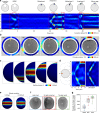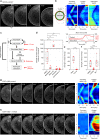A cdk1 gradient guides surface contraction waves in oocytes
- PMID: 29021609
- PMCID: PMC5636809
- DOI: 10.1038/s41467-017-00979-6
A cdk1 gradient guides surface contraction waves in oocytes
Erratum in
-
Publisher Correction: A cdk1 gradient guides surface contraction waves in oocytes.Nat Commun. 2018 Jan 10;9(1):200. doi: 10.1038/s41467-017-02520-1. Nat Commun. 2018. PMID: 29321627 Free PMC article.
Abstract
Surface contraction waves (SCWs) in oocytes and embryos lead to large-scale shape changes coupled to cell cycle transitions and are spatially coordinated with the cell axis. Here, we show that SCWs in the starfish oocyte are generated by a traveling band of myosin II-driven cortical contractility. At the front of the band, contractility is activated by removal of cdk1 inhibition of the RhoA/RhoA kinase/myosin II signaling module, while at the rear, contractility is switched off by negative feedback originating downstream of RhoA kinase. The SCW's directionality and speed are controlled by a spatiotemporal gradient of cdk1-cyclinB. This gradient is formed by the release of cdk1-cyclinB from the asymmetrically located nucleus, and progressive degradation of cyclinB. By combining quantitative imaging, biochemical and mechanical perturbations with mathematical modeling, we demonstrate that the SCWs result from the spatiotemporal integration of two conserved regulatory modules, cdk1-cyclinB for cell cycle regulation and RhoA/Rok/NMYII for actomyosin contractility.Surface contraction waves (SCWs) are prominent shape changes coupled to cell cycle transitions in oocytes. Here the authors show that SCWs are patterned by the spatiotemporal integration of two conserved modules, cdk1-cyclinB for cell cycle regulation and RhoA/Rok/NMYII for actomyosin contractility.
Conflict of interest statement
The authors declare no competing financial interests.
Figures




Similar articles
-
SGK regulates pH increase and cyclin B-Cdk1 activation to resume meiosis in starfish ovarian oocytes.J Cell Biol. 2019 Nov 4;218(11):3612-3629. doi: 10.1083/jcb.201812133. Epub 2019 Sep 19. J Cell Biol. 2019. PMID: 31537709 Free PMC article.
-
A primer on meiotic resumption in starfish oocytes: the proposed signaling pathway triggered by maturation-inducing hormone.Mol Reprod Dev. 2011 Oct-Nov;78(10-11):704-7. doi: 10.1002/mrd.21343. Epub 2011 Jun 28. Mol Reprod Dev. 2011. PMID: 21714029 Review.
-
In vivo regulation of cyclin A/Cdc2 and cyclin B/Cdc2 through meiotic and early cleavage cycles in starfish.Dev Biol. 1998 May 1;197(1):39-53. doi: 10.1006/dbio.1998.8881. Dev Biol. 1998. PMID: 9578617
-
From ubiquitin-proteasomal degradation to CDK1 inactivation: requirements for the first polar body extrusion in mouse oocytes.FASEB J. 2012 Nov;26(11):4495-505. doi: 10.1096/fj.12-209866. Epub 2012 Aug 2. FASEB J. 2012. PMID: 22859367
-
MPF-based meiotic cell cycle control: Half a century of lessons from starfish oocytes.Proc Jpn Acad Ser B Phys Biol Sci. 2018;94(4):180-203. doi: 10.2183/pjab.94.013. Proc Jpn Acad Ser B Phys Biol Sci. 2018. PMID: 29643273 Free PMC article. Review.
Cited by
-
Polarized Dishevelled dissolution and reassembly drives embryonic axis specification in sea star oocytes.Curr Biol. 2021 Dec 20;31(24):5633-5641.e4. doi: 10.1016/j.cub.2021.10.022. Epub 2021 Nov 4. Curr Biol. 2021. PMID: 34739818 Free PMC article.
-
A disassembly-driven mechanism explains F-actin-mediated chromosome transport in starfish oocytes.Elife. 2018 Jan 19;7:e31469. doi: 10.7554/eLife.31469. Elife. 2018. PMID: 29350616 Free PMC article.
-
Proteomics of phosphorylation and protein dynamics during fertilization and meiotic exit in the Xenopus egg.Proc Natl Acad Sci U S A. 2017 Dec 12;114(50):E10838-E10847. doi: 10.1073/pnas.1709207114. Epub 2017 Nov 28. Proc Natl Acad Sci U S A. 2017. PMID: 29183978 Free PMC article.
-
Dynamics of hydraulic and contractile wave-mediated fluid transport during Drosophila oogenesis.Proc Natl Acad Sci U S A. 2021 Mar 9;118(10):e2019749118. doi: 10.1073/pnas.2019749118. Proc Natl Acad Sci U S A. 2021. PMID: 33658367 Free PMC article.
-
Flow Induced Symmetry Breaking in a Conceptual Polarity Model.Cells. 2020 Jun 23;9(6):1524. doi: 10.3390/cells9061524. Cells. 2020. PMID: 32585819 Free PMC article.
References
-
- Yoneda M, Kobayakawa Y, Kubota HY, Sakai M. Surface contraction waves in amphibian eggs. J. Cell. Sci. 1982;54:35–46. - PubMed
Publication types
MeSH terms
Substances
LinkOut - more resources
Full Text Sources
Other Literature Sources
Molecular Biology Databases
Miscellaneous

